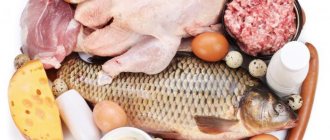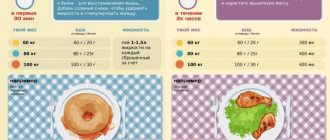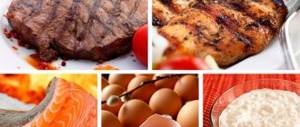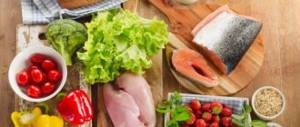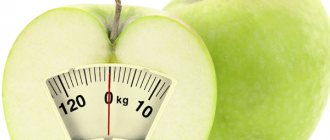Share:
It is important for every athlete not only to choose the right training program, but also to take a responsible approach to nutrition. Gaining muscle mass will not be achieved if you do not watch what, how and when you eat.
The first thing all athletes should learn is that nutrition when gaining muscle mass is very different from so-called proper nutrition, and even more so from a diet when losing weight. What exactly are these differences, you will learn from our article.
Calculation of basal metabolism
No matter what your goal is - losing weight or gaining muscle mass - you first need to know your metabolic rate and calculate your basal metabolism. This way you will find out how many calories your body needs for full functioning with minimal physical activity.
Factors such as gender, height, weight and age are taken into account. Keep in mind that the results obtained are only approximate, since individual factors that influence metabolism are also important - the presence or absence of bad habits, features of the endocrine system, genetics and much more. Your basal metabolic rate corresponds to the number of calories you need to maintain your weight.
It is calculated using the following formulas given in the table:
| Floor | Formula |
| Men | 66 + (13.7 x body weight) + (5 x height in cm) – (6.8 x age in years) |
| Women | 655 + (9.6 x body weight) + (1.8 x height in cm) – (4.7 x age in years) |
Next, we multiply the resulting number by the level of physical activity:
- 1.2 – predominantly sedentary lifestyle;
- 1.375 – average activity level, 1-3 light workouts per week;
- 1.55 – high level of activity, 3-5 intense workouts per week;
- 1.725 – very high level of activity, heavy physical activity 6-7 times a week.
The final figure will roughly reflect how many calories you need to maintain your weight. Further actions are simple: if you want to lose weight, this number should be gradually reduced, if you want to gain weight, increase it.
Is it possible to eat at night?
Often, work schedule interferes with visiting the gym and training has to be postponed to the evening. But this is not a reason to refuse to eat, because the body needs to restore energy reserves to maintain natural functions. In this case, the amount of incoming energy should prevail over the costs, which will ensure the desired gain of muscle mass. Therefore, you should definitely eat before going to bed. For a late dinner, you need to choose slow proteins, avoiding the consumption of carbohydrates and fats. Low-fat cottage cheese is best suited for this purpose - 100 - 150 g is enough. The casein it contains will be absorbed in about 5 hours, supplying the body with energy for restoration and muscle building. To enhance the effect and to diversify your menu, cottage cheese can be consumed with low-fat sour cream or kefir.
Please help make this article better. Answer just 3 questions.
Interesting to know!
True bodybuilding fans practice an unusual diet - they eat before bed and wake up every 2 to 3 hours to eat. Thus, they provide a constant supply of energy and continuous protein synthesis for weight gain.
Nutrition program for gaining muscle mass
Muscle growth is impossible without regular proper nutrition. Choose the highest quality products so as not to pollute your body with toxins and waste. When choosing protein, give preference to chilled meat, fish and poultry. Among carbohydrates, the most useful cereals are those that have undergone the least technical processing - they retain a large amount of fiber and beneficial microelements. There is almost nothing useful left in polished cereals.
Give preference to carbohydrates with a low glycemic index; their intake does not lead to an intense release of insulin, which means you will not gain excess fat. Leave simple carbohydrates for Saturday or Sunday; on this day you can easily afford to have a cheat-day and eat whatever you want. This will speed up your metabolism even more, create a positive psychological effect and simply allow you to enjoy delicious food.
The frequency of strength training in the gym is also important. The more often you exercise, the more energy you expend. To gain weight, the calories burned need to be more than compensated for. Therefore, on training days, eat one or two more meals than on rest days. This will significantly speed up the recovery process.
Basic principles
To make it easier for novice athletes to understand what to start from when creating a diet for gaining muscle mass for a week, let’s summarize a few basic principles:
- Immediately after waking up, it is recommended to drink 1-2 glasses of still water. This will prepare your gastrointestinal tract for the upcoming breakfast and normalize the water-salt balance in the body.
- Breakfast is the most abundant and high-calorie meal of the day. It should be based on complex carbohydrates, and a moderate amount of protein and unsaturated fatty acids will also benefit. It is acceptable to eat some simple carbohydrates and drink a cup of coffee to quickly wake up and recharge your batteries.
- Eat several meals throughout the day. It is advisable to have a variety to get different amino acids from different protein sources. For some, two meals are enough to complete the diet, while for others, even five meals are not enough. It all depends on your body type, metabolism, genetics, the functioning of the gastrointestinal tract and the level of daily physical activity. Portions should be small so that you feel hungry again two to three hours after eating. Meals should consist of animal protein, complex carbohydrates and fiber.
- Load up on carbohydrates before your workout. This will give you strength and improve blood flow to the muscles due to more glycogen. After a workout, you will need fast-absorbing protein. Egg whites or protein shakes are best.
- Most nutritionists recommend limiting carbohydrate intake after 6-7 pm or avoiding them altogether. Of course, this largely depends on your schedule and your body’s needs, but the point is clear: the closer you sleep, the less energy your body requires. Surges in insulin levels at this time will lead to the accumulation of fatty tissue, and overworking the pancreas is also not recommended.
- The last meal should consist of slow-digesting protein. This will prevent muscle tissue breakdown while you sleep. The ideal option for this is low-fat cottage cheese. This is a light and low-calorie product that will supply muscles with amino acids for 4-6 hours.
- Don't forget the importance of water. Gaining weight involves eating large amounts of protein foods, which puts a lot of stress on the gastrointestinal tract, liver and kidneys. To avoid harming your health, be sure to drink enough water. Your minimum norm is 3 liters per day. This will normalize appetite, improve skin condition and speed up metabolic processes in the body.
- Cheat-day cheat-day discord. Of course, it is worth periodically giving yourself a little rest from proper nutrition, but not everyone and not always will benefit from this. It is better for endomorphs to use a refeed (loading with complex carbohydrates) instead of a classic cheat day. This will replenish glycogen stores in the muscles and liver, but will not lead to the growth of adipose tissue.
For men
For men, gaining muscle mass is associated with an increase in strength in basic exercises. Of course, this requires energy, which the body receives mainly from carbohydrates. There should be a lot of carbohydrates: depending on daily activity and tendency to gain weight, their amount varies from 4 to 10 g per 1 kg of weight per day. This is a large volume of food, so it will be more convenient to divide it into several parts. The more often you eat, the easier it will be for your gastrointestinal tract to absorb all that food.
All carbohydrate sources are weighed in dry (raw) form. This greatly simplifies all calculations. For example, 100 g of oatmeal (dry) contains about 65 g of carbohydrates. Write this meal down in your food diary so it will be easier for you to figure out how many macronutrients you need to eat afterwards throughout the day.
By the way, you don’t need to be afraid of simple carbohydrates either. If you are not prone to diabetes and do not have problems with excess weight, you can easily afford some simple carbohydrates every day. Of course, it will be better if you get them from natural sources: fruits, berries or honey. Confectionery products, such as various cakes, chocolate bars, and baked goods, in addition to sugar, contain large amounts of saturated fatty acids. Together, this causes a strong surge in insulin, which sooner or later will lead to excess fat gain, even in ectomorphs.
How to eat while gaining muscle mass to get the maximum benefit from working out in the gym? Additionally, take special supplements for athletes in strictly dosed quantities. Besides energy, you need strength. ATP molecules are responsible for the strength of muscles and the load they can withstand. The fewer there are, the fewer repetitions you can do when working with a certain weight. Creatine promotes the accumulation of ATP molecules.
In addition to sports nutrition products, creatine is found in large quantities in red meat: beef, pork, lamb. The conclusion is simple: men should definitely add red meat to their diet on a regular basis to gain muscle mass. Creatine also has another beneficial property: it improves the flow of glycogen and water into the muscles. As you know, one glycogen molecule “attracts” four water molecules. Due to this, the muscles visually look stiffer and fuller.
Red meat is not the only source of protein. Proper nutrition for gaining muscle mass involves getting protein from a variety of foods. The following are excellent sources of protein: chicken and turkey fillet, dairy products, fish and seafood. Vegetable protein obtained from cereals and legumes may not be taken into account in the overall calculation of macronutrients. Its amino acid composition is not as rich as that of animal proteins. Total protein in the diet should be at least 1.5-2 g per 1 kg of body weight. This is the minimum amount that can replenish your energy costs and start the process of muscle tissue restoration after strength training.
For the normal absorption of protein foods, the body needs fiber. Preferably obtained from fresh vegetables and fruits. Fiber is considered a non-digestible carbohydrate, so it may not be included in your overall macronutrient count.
Without what else is it impossible to gain muscle mass? Without increased hormonal levels. It has been proven that strength training promotes increased secretion of testosterone and growth hormone. But where does the body get fuel for their synthesis? Hormones are synthesized from cholesterol. To put it simply, cholesterol can be “good” and “bad”. “Bad” cholesterol is found in trans fats and has an extremely negative effect on the cardiovascular system.
“Good” cholesterol is found in plant foods and performs many beneficial functions, including:
- normalization of the endocrine system;
- reducing the level of “bad” cholesterol in the blood;
- increased sexual activity;
- improving the functioning of the digestive system.
Conclusion: the body needs fats. The best sources of fats: vegetable oils (linseed, olive, sesame, grape seed oil), fish oil, egg yolks, nuts, seeds, avocados.
For women
The principles of proper nutrition for female athletes gaining muscle mass are almost the same. You must take in more energy than you expend, have enough protein building blocks for muscle repair and growth, and consume enough fat for the normal functioning of all body systems.
Focus on the quality of the food. “Dirty” food is unacceptable. Everyone knows that women store excess weight differently than men: most fat accumulates on the buttocks, lower abdomen and inner thighs. This is incompatible with an aesthetically pleasing athletic physique. It is unhealthy foods that contribute to fat accumulation: foods with a high glycemic index, fast food and convenience foods.
Your norm of carbohydrates is 3.5-6 g, proteins – 1.5-2 g, fats – 0.5-1 g per 1 kg of body weight. If the products are of high quality, this will be enough to provide the body with everything it needs.
How long after training should you eat?
After intense exercise in the gym, the so-called anabolic window opens in the human body - a state of the body in which there is a deficiency of nutrients - proteins and carbohydrates (therefore, the condition is also called the protein-carbohydrate window). You can quickly compensate for the resulting deficiency by eating food. And since the average duration of the anabolic window is 40 – 90 minutes, you need to eat exactly during this period of time. However, not everything is so simple and there are several opinions on this matter.
- To prevent further muscle breakdown, you should eat immediately after training.
- You need to eat after 1 hour, during which the body will burn its own fat reserves.
- You need to consume exclusively proteins, which will help restore damaged muscle fibers.
- It is better to give preference to carbohydrates, due to which the body’s energy potential will be restored.
- You can eat both proteins and carbohydrates, since the body needs them to ensure muscle growth. The main thing is to stay within the anabolic window.
In principle, any of these opinions has practical confirmation and real results in muscle growth. And the only thing that needs to be taken into account is whether the person ate before training. If not, then after class you need to eat as soon as possible. If the exercises were performed on a full stomach, then you can take your time eating.
Best Foods for Muscle Growth
Below is a list of the best foods for bodybuilding and their macronutrient composition. With this information, you can develop a balanced bodybuilding diet based on your goals (muscle building, fat loss, or maintaining your current shape).
Meat, fish, poultry (per 28 g)
| Product | Calorie content (Kcal) | Proteins (g) | Carbohydrates (g) | Fat (g) |
| Atlantic salmon | 56.6 | 7.7 | 0 | 2.4 |
| Back bacon (grilled) | 27.0 | 3.4 | 0 | 1.2 |
| Beef (low-fat minced meat) | 53.0 | 8.0 | 0 | 2.1 |
| Beef (thigh) | 54.4 | 8.7 | 0 | 1.8 |
| Beef (grilled sirloin) | 64.0 | 9.3 | 0 | 2.8 |
| Beef (top side) | 54.7 | 9.9 | 0 | 1.5 |
| Catfish (fillet) | 46.6 | 8.0 | 0 | 1.2 |
| Chicken (breast) | 49.7 | 9.6 | 0 | 1.2 |
| Chicken (leg) | 23.6 | 3.7 | 0 | 0.9 |
| Chicken (thigh) | 33.6 | 4.3 | 0 | 4.3 |
| Cod | 32.6 | 7.1 | 0 | 0.3 |
| Crab (Alaskan) | 30.1 | 5.9 | 0 | 0.6 |
| Roast beef delicacy | 15.5 | 2.5 | 0.6 | 0.3 |
| Halibut | 43.5 | 8.4 | 0 | 0.9 |
| Ham (lean, shredded) | 40.7 | 6.2 | 0.3 | 1.5 |
| Lamb (leg) | 63.7 | 8.2 | 0 | 3.7 |
| Pork tenderloin | 51.0 | 8.7 | 0 | 1.5 |
| Scallops | 27.3 | 5.2 | 0.9 | 0.3 |
| Shrimps | 30.8 | 6.5 | 0 | 0 |
| Tuna (bluefish, fresh) | 57.2 | 9.3 | 0 | 1.8 |
| Tuna (white, canned) | 39.8 | 8.0 | 0 | 0.9 |
| Turkey (breast) | 42.9 | 9.3 | 0 | 0 |
| Venison (tenderloin) | 46.3 | 9.3 | 0 | 0.6 |
Eggs and dairy products (per 28 g)
| Product | Calorie content (Kcal) | Proteins (g) | Carbohydrates (g) | Fat (g) |
| Egg (whole – 1 large) | 74 | 6.0 | insignificant | 5.0 |
| Egg (substitute-50 ml) | 53 | 8.0 | insignificant | 2.0 |
| Egg (white - 1 large) | 18.0 | 4.0 | insignificant | insignificant |
| Low fat serum (250 ml) | 98.0 | 8.0 | 12 | 2.0 |
| Ricotta cheese (partially skim) | 38.3 | 3.13 | 1.3 | 2.24 |
| Yogurt (low fat, no fillers) | 15.8 | 1.6 | 2.1 | insignificant |
| Cheddar cheese (reduced fat) | 54.8 | 7.8 | 1.1 | 2.2 |
| Swiss cheese (low fat) | 56.0 | 8.9 | 1.1 | 1.1 |
| Skim milk (250 ml) | 86 | 8.0 | 12 | insignificant |
| Cottage cheese (2%) | 25.0 | 4.0 | 1.0 | 1 |
Nuts, seeds, oils (per 28 g)
| Product | Calorie content (Kcal) | Proteins (g) | Carbohydrates (g) | Fat (g) |
| Almond | 183 | 6.7 | 6.7 | 15.6 |
| Almond oil (1 tbsp) | 101 | 2.5 | 3.5 | 9.5 |
| Canola oil (1 tbsp) | 124 | 0.0 | 0.0 | 14 |
| Flax seeds (1 tbsp.) | 59 | 2.3 | 4.0 | 4.0 |
| Olive oil (1 tbsp.) | 119 | 0.0 | 0.0 | 14 |
| Peanut butter | 96 | 4.0 | 3.0 | 8.5 |
| Peanuts (roasted) | 186 | 7.8 | 6.7 | 15.6 |
| Walnuts | 207 | 4.5 | 4.5 | 21.2 |
Cereals, bread, pasta (per 28 g)
| Product | Calorie content (Kcal) | Proteins (g) | Carbohydrates (g) | Fat (g) |
| Bagel, without filling (1 small – 7 cm) | 190 | 7 | 37 | 1 |
| Barley (cooked) | 33.7 | 7 | 7.7 | 0.1 |
| Bran muffin (1 small) | 178 | 5 | 32 | 5 |
| Brown rice (cooked) | 31.1 | 0.7 | 6.4 | 0.2 |
| Corn tortilla (1) | 58 | 2 | 12 | 1 |
| Couscous (cooked) | 30.8 | 1 | 6.4 | insignificant |
| Pumpkin (1) | 134 | 4 | 26 | 1 |
| Flour tortilla (diameter 20 cm) | 146 | 4 | 25 | 3 |
| Pasta (whole grain) | 39.3 | 1.4 | 8 | 0.2 |
| Oatmeal (cooked) | 17.2 | 0.7 | 3.0 | 0.2 |
| Rye bread (1 slice) | 83 | 3.0 | 16 | 1.0 |
| Yeast bread (1 slice) | 88 | 3.0 | 17 | 1.0 |
| Spaghetti (whole grain, cooked) | 39.3 | 1.4 | 8.0 | 0.2 |
| Wheat germ (1 tbsp) | 26 | 2.0 | 4.0 | 0.5 |
| White rice (cooked) | 31 | 0.6 | 6.8 | insignificant |
| Whole grain flakes | 84 | 2.0 | 21.4 | 0.9 |
| Whole grain crackers (5) | 90 | 2.0 | 14 | 3.0 |
| Whole wheat bread (1 slice) | 73 | 3.0 | 13 | 1 |
| Whole Wheat Pitta (1) | 170 | 6.0 | 35 | 2.0 |
| Whole Wheat Pretzel | 115 | 3.3 | 21.4 | 0.9 |
| Black rice (cooked) | 28.1 | 1.1 | 5.9 | 0.1 |
Fruit (per 28 g)
| Product | Calorie content (Kcal) | Proteins (g) | Carbohydrates (g) | Fat (g) |
| Apple 1 (average) | 72 | insignificant | 19 | insignificant |
| Apricot (3) | 50 | 2.0 | 12 | insignificant |
| Avocado (1/4) | 80 | 1.0 | 4.0 | 7.0 |
| Banana (1 medium) | 105 | 1.0 | 30 | insignificant |
| Blueberry | 50.6 | 0.1 | 3.9 | insignificant |
| Cantaloupe | 9.4 | 0.1 | 2.2 | insignificant |
| Cherry (sour) | 14 | 0.3 | 3.4 | insignificant |
| Grapefruit (1/2 medium) | 41 | 1.0 | 10 | insignificant |
| Grape juice (100 ml) | 45.2 | insignificant | 19 | insignificant |
| Grapes (seedless) | 20 | 0.1 | 5.4 | insignificant |
| White melon (diced) | 10 | 0.1 | 5.4 | insignificant |
| Mango (diced) | 18 | 0.1 | 4.7 | insignificant |
| Nectarine (1 medium) | 60 | 1.0 | 14 | insignificant |
| Orange Navel (1) | 69 | 1.0 | 18 | insignificant |
| Orange juice (100 ml) | 44.8 | 0.8 | 26 | insignificant |
| Papaya (diced) | 10.9 | 0.1 | 2.8 | insignificant |
| Peach (1 medium) | 38 | 1.0 | 9.0 | insignificant |
| Pear (1 medium) | 96 | 1.0 | 26 | insignificant |
| Pineapple (diced) | 13.3 | 1.0 | 20 | insignificant |
| Plum (1) | 30 | insignificant | 8.0 | insignificant |
| Raisin | 86.3 | 0.7 | 23 | insignificant |
| Raspberries | 14.3 | 0.4 | 3.3 | 0.1 |
| Strawberry | 9.1 | 0.1 | 2.2 | insignificant |
| Watermelon (diced) | 8.5 | 0.1 | 2.2 | insignificant |
Legumes (per 28 g)
| Product | Calorie content (Kcal) | Proteins (g) | Carbohydrates (g) | Fat (g) |
| Moon beans (baby) | 33.8 | 2.0 | 6.1 | insignificant |
| Black beans | 36.8 | 2.3 | 6.5 | insignificant |
| Chickpeas | 46.9 | 2.4 | 8.0 | 0.7 |
| Common beans | 34 | 2.4 | 8.0 | insignificant |
| Lentils (cooked) | 32 | 2.5 | 5.6 | insignificant |
| Tofu (raw) | 45 | 4.9 | 1.1 | 2.5 |
| Soybeans (cooked) | 79 | 6.8 | 6.2 | 3.1 |
| Split peas (cooked) | 32.4 | 2.2 | 5.8 | insignificant |
Vegetables (per 28 g)
| Product | Calorie content (Kcal) | Proteins (g) | Carbohydrates (g) | Fat (g) |
| Artichokes (1 medium) | 60 | 4.0 | 13 | insignificant |
| Asparagus (4 large pods) | 16 | 2.0 | 3.0 | insignificant |
| Eggplant (diced) | 7.0 | insignificant | 1.4 | insignificant |
| Beets (sliced, cooked) | 2.35 | 0.8 | 2.8 | insignificant |
| Broccoli (florets, raw) | 7.7 | 0.6 | 1.2 | insignificant |
| Brussels sprouts | 10 | 1.2 | 2.0 | insignificant |
| Butternut squash | 11.5 | 0.3 | 3.0 | insignificant |
| Cabbage (shredded) | 6.8 | 0.4 | 1.6 | insignificant |
| Carrot (1 large) | 30 | 1.0 | 7 | insignificant |
| Cauliflower | 7.0 | 0.5 | 2.0 | insignificant |
| Chinese cabbage (cooked) | 3.3 | 0.5 | .05 | insignificant |
| Collard greens (chopped) | 1.6 | 0.1 | 0.3 | insignificant |
| Corn, grains | 22 | 1.0. | 5.0 | 0.3 |
| Zucchini (chopped) | 5.0 | 0.4 | 0.9 | insignificant |
| Cucumber (sliced) | 4.3 | 0.2 | 1.0 | insignificant |
| Garlic (1 clove) | 5.0 | insignificant | 1.0 | insignificant |
| Green beans | 3.7 | 0.5 | 2.0 | insignificant |
| Green peas (raw) | 24 | 1.6 | 4.3 | insignificant |
| Kale (shredded) | 6.5 | 0.6 | 1.5 | 0.2 |
| Mushrooms (slices) | 6.0 | 0.8 | 0.8 | insignificant |
| Onion (chopped) | 11.5 | 0.3 | 2.8 | insignificant |
| Bell pepper (green, chopped) | 5.6 | 0.2 | 1.3 | insignificant |
| Potatoes (1 medium) baked | 161 | 4.0 | 37 | insignificant |
| Potatoes (boiled) | 24 | 0.0 | 6.0 | 0.0 |
| Potatoes (mashed with milk) | 23 | 1.0 | 5.0 | 0.0 |
| Pumpkin (fresh) | 5.6 | 0.2 | 1.2 | insignificant |
| Romaine lettuce (shredded) | 6.2 | 0.6 | 1.2 | insignificant |
| Spinach | 7.0 | 1.0 | 1.0 | insignificant |
| Sweet potato (1 medium, baked) | 103 | 2.0 | 24 | insignificant |
| Tomato (1 large) | 33 | 2.0 | 7.0 | insignificant |
| Tomato juice (100 ml) | 16 | 0.8 | 4.0 | insignificant |
Features of use for different groups of people
It is much easier for men to gain muscle weight, since testosterone helps them with this. This male hormone is anabolic and promotes rapid growth of muscle fibers. It is not present in the female body, so it is more difficult for girls to create the desired relief. In addition, women's metabolism is designed in such a way that fat reserves are formed much easier than muscles.
To build muscle, it is important for men to include animal fats in their diet (in moderation): they contain cholesterol, from which testosterone is formed in the body. Also on the menu must be eggs, chicken, beef, buckwheat, almonds, and broccoli.
Women should focus on plant foods, since animal fats will go into fat reserves and not into muscles. The menu should include dairy products, especially cottage cheese and milk, soybeans, eggs, fish and chicken.

